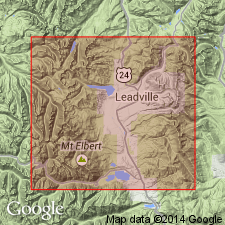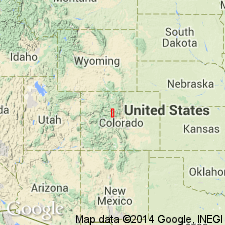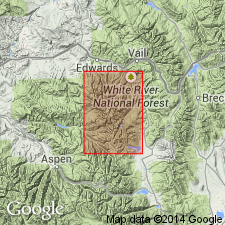
- Usage in publication:
-
- Lincoln porphyry*
- Modifications:
-
- Named
- Dominant lithology:
-
- Porphyry
- AAPG geologic province:
-
- Eagle basin
- South Park basin
Summary:
Named for development around Mount Lincoln [which lies north of Alma, Park Co, CO in the South Park basin, according to Wilmarth (1938, US geologic names lexicon, USGS Bull. 896)]. Mapped with other porphyries on geologic map. Consists of quartz, orthoclase and plagioclase feldspars, and biotite. Its most striking peculiarity is the frequent occurrence of large crystals of glassy-looking orthoclase feldspar about 1 in long. Quartz occurs in double pyramids, has a rounded outline, and frequently a rose tint. Mica generally decomposed and of greenish color. Age not clearly stated. [Is probably a Tertiary porphyry].
Source: GNU records (USGS DDS-6; Denver GNULEX).

- Usage in publication:
-
- Lincoln porphyry*
- Modifications:
-
- Overview
- AAPG geologic province:
-
- Eagle basin
Summary:
Is a quartz monzonite porphyry in Eagle basin. Contains large phenocrysts of light-gray or pink orthoclase. Is younger than Elk Mountain porphyry and older than Eagle River porphyry. Assigned to early Tertiary.
Source: GNU records (USGS DDS-6; Denver GNULEX).

- Usage in publication:
-
- Lincoln Porphyry*
- Modifications:
-
- Geochronologic dating
- AAPG geologic province:
-
- Eagle basin
Summary:
Has a K-Ar date on biotite of 64 m.y. Is one of youngest of porphyries, or of very early Paleocene age.
Source: GNU records (USGS DDS-6; Denver GNULEX).

- Usage in publication:
-
- Lincoln Porphyry*
- Modifications:
-
- Areal extent
- AAPG geologic province:
-
- Eagle basin
Summary:
A coarse-grained porphyritic monzogranite mapped as Paleocene by Tweto (1960) mapped as the Oligocene (35.6 +/-1.2 m.y. K-Ar date) Turquoise Lake stock in Eagle basin.
Source: GNU records (USGS DDS-6; Denver GNULEX).
For more information, please contact Nancy Stamm, Geologic Names Committee Secretary.
Asterisk (*) indicates published by U.S. Geological Survey authors.
"No current usage" (†) implies that a name has been abandoned or has fallen into disuse. Former usage and, if known, replacement name given in parentheses ( ).
Slash (/) indicates name conflicts with nomenclatural guidelines (CSN, 1933; ACSN, 1961, 1970; NACSN, 1983, 2005, 2021). May be explained within brackets ([ ]).

